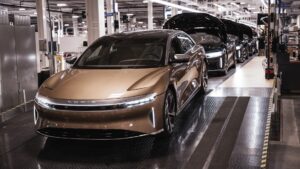The Auto Industry’s Overhaul: From Capital Junkies to Cost-Cutting Strategies
As the electric vehicle (EV) revolution accelerates, the automotive industry finds itself at a crossroads. Lucid Motors, a rising start-up, made headlines recently when it commenced the production of its first customer cars at its Casa Grande, Arizona facility. While this is noteworthy, many legacy automakers are grappling with the consequences of years of unchecked spending on EVs and autonomous driving technologies.
A Wake-Up Call for Automakers
Reflecting on the industry’s current state, it’s clear that automakers have developed an addiction to capital investments—often referred to as being "capital junkies." Companies from Detroit to Tokyo are now seeking to reverse years of heavy spending, marked by billions sunk into technologies that are not yielding the expected short- to medium-term returns. The struggle is further complicated by rising commodity costs, geopolitical tensions, and a noticeable dip in consumer demand.
General Motors (GM) and Ford Motor Company are at the forefront of this cost-cutting wave, each aiming to reduce fixed costs by billions. This includes significant layoffs and strategic pivots to ensure their survival in an increasingly competitive landscape. Meanwhile, competitors like Nissan, Volkswagen, and the Stellantis group are enacting drastic workforce reductions and re-evaluating their production strategies.
Morgan Stanley analyst Adam Jonas highlights the industry’s new focus on “capital efficiency.” The goal is to streamline operations, lessen expenditures, and increase collaboration, all while continuing to prioritize profit.
The Impact of Unsustainable Spending
The automotive sector operates on an intricate network of suppliers and manufacturers, necessitating considerable initial investment for any new product. Yet, over the last several years, the industry has escalated spending on EVs and autonomous technologies into overdrive. AlixPartners reports that R&D and capital expenditures for the top 25 global automotive companies soared from roughly $200 billion in 2015 to an unprecedented $266 billion in 2023.
This surge posed significant challenges: for instance, GM’s spending increased by approximately 62%, bringing its R&D costs to $20.6 billion, even as global sales plummeted by 38%. By contrast, Ford and Volkswagen saw increases of 18% and 42%, respectively.
EV startups like Rivian and Lucid, on the other hand, are cooling their jets after burning through $16 billion and $8.8 billion in cash flow since 2022. Despite scaling up production efforts, their futures hinge on capital management and shareholder confidence.
A Historical Perspective
This latest round of cost-cutting sends echoes back to 2015 when the legendary late Fiat Chrysler CEO, Sergio Marchionne, delivered his infamous "Confessions of a Capital Junkie" presentation. This pointed out the dire need for consolidation within the industry to tackle overlapping investments—insights that remain relevant today.
Morgan Stanley’s "Sergio Quotient" illustrates the financial herculean task faced by traditional automakers, with Ford and GM spending their market cap in just 2.6 and 1.9 years, respectively. This poor capital efficiency has raised concerns among investors who question the sustainability of such practices.
Strategic Partnerships and Collaborations
To curb wasteful spending, major players are now considering tighter collaborations. For example, GM and Hyundai have publicly committed to exploring "future collaborations across key strategic areas."
Companies like Volkswagen are in a precarious position, too, as they embark on drastic cost-cutting measures that might even involve layoffs in their German facilities to address the continuing struggles in markets like Europe and China.
The Road Ahead: A Balancing Act
While companies face myriad challenges, those like GM are striking a balance between investment and cost management. With around $27 billion in free cash flow at the end of Q3 2023, GM remains a standout example in an industry riddled with volatility. CEO Mary Barra has made clear commitments to limit capex to approximately $11 billion moving forward, an approach emphasizing disciplined investment allocations.
For startups, the path isn’t easy, but partnerships like Rivian’s expected software collaboration with Volkswagen may offer them the lifelines needed to navigate this turbulent phase.
Conclusion
The automotive industry is in the throes of significant transformation, necessitated by vast overhauls in strategy and operations. As legacy automakers and EV startups alike reassess and restructure their financial models, the question remains: Can they break free from the capital addiction that has plagued them for so long?
At Extreme Investor Network, we remain committed to analyzing these pivotal changes, providing our readers with insights that help them make informed investment choices in this dynamic landscape. Stay tuned as we continue to monitor how the industry adapts and evolves.

